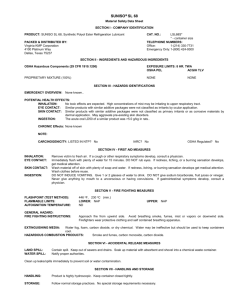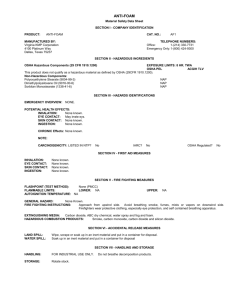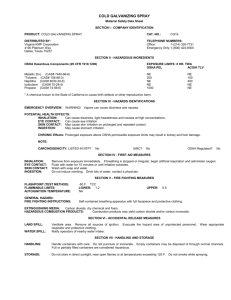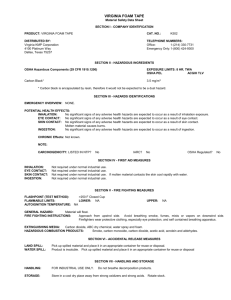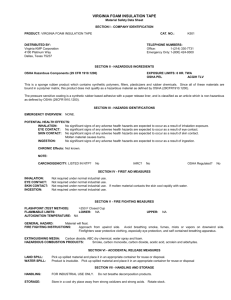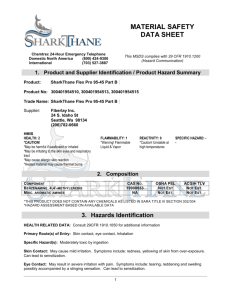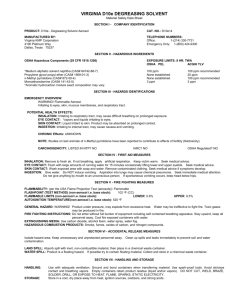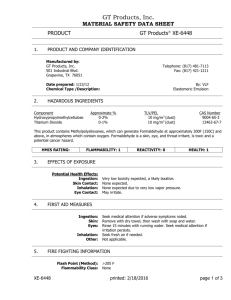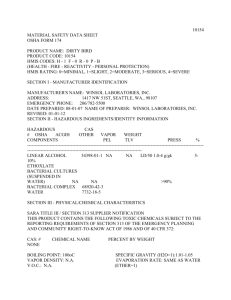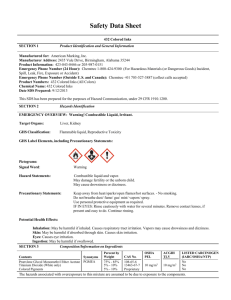Ca16
advertisement
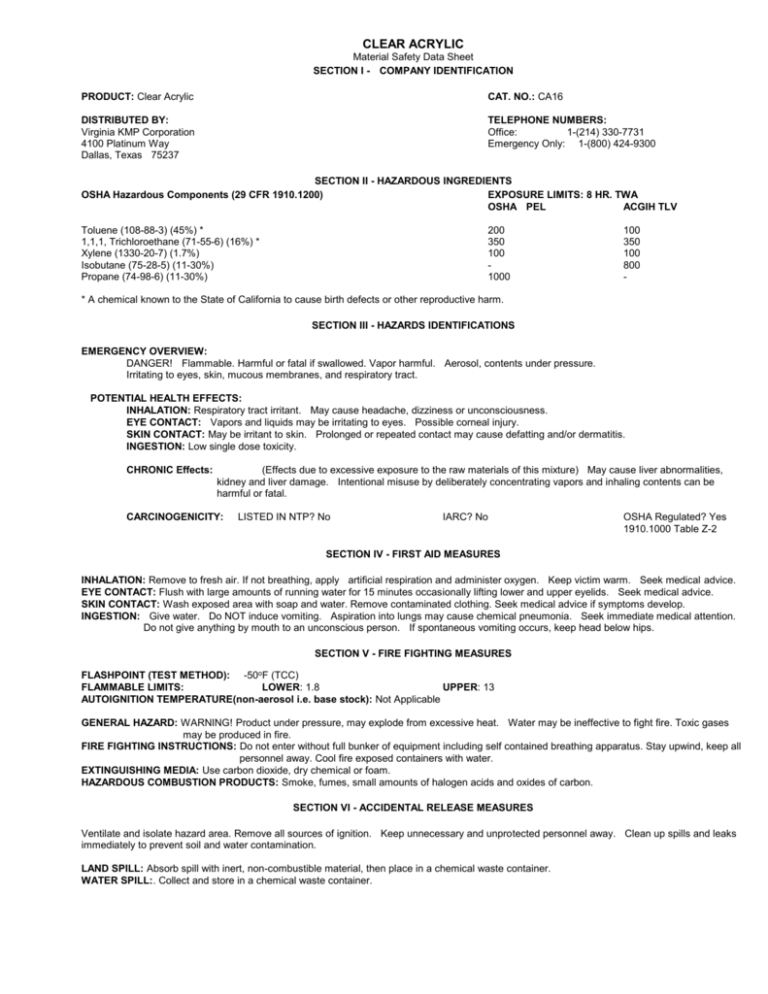
CLEAR ACRYLIC Material Safety Data Sheet SECTION I - COMPANY IDENTIFICATION PRODUCT: Clear Acrylic CAT. NO.: CA16 DISTRIBUTED BY: Virginia KMP Corporation 4100 Platinum Way Dallas, Texas 75237 TELEPHONE NUMBERS: Office: 1-(214) 330-7731 Emergency Only: 1-(800) 424-9300 SECTION II - HAZARDOUS INGREDIENTS OSHA Hazardous Components (29 CFR 1910.1200) EXPOSURE LIMITS: 8 HR. TWA OSHA PEL ACGIH TLV Toluene (108-88-3) (45%) * 1,1,1, Trichloroethane (71-55-6) (16%) * Xylene (1330-20-7) (1.7%) Isobutane (75-28-5) (11-30%) Propane (74-98-6) (11-30%) 200 350 100 1000 100 350 100 800 - * A chemical known to the State of California to cause birth defects or other reproductive harm. SECTION III - HAZARDS IDENTIFICATIONS EMERGENCY OVERVIEW: DANGER! Flammable. Harmful or fatal if swallowed. Vapor harmful. Aerosol, contents under pressure. Irritating to eyes, skin, mucous membranes, and respiratory tract. POTENTIAL HEALTH EFFECTS: INHALATION: Respiratory tract irritant. May cause headache, dizziness or unconsciousness. EYE CONTACT: Vapors and liquids may be irritating to eyes. Possible corneal injury. SKIN CONTACT: May be irritant to skin. Prolonged or repeated contact may cause defatting and/or dermatitis. INGESTION: Low single dose toxicity. CHRONIC Effects: (Effects due to excessive exposure to the raw materials of this mixture) May cause liver abnormalities, kidney and liver damage. Intentional misuse by deliberately concentrating vapors and inhaling contents can be harmful or fatal. CARCINOGENICITY: LISTED IN NTP? No IARC? No OSHA Regulated? Yes 1910.1000 Table Z-2 SECTION IV - FIRST AID MEASURES INHALATION: Remove to fresh air. If not breathing, apply artificial respiration and administer oxygen. Keep victim warm. Seek medical advice. EYE CONTACT: Flush with large amounts of running water for 15 minutes occasionally lifting lower and upper eyelids. Seek medical advice. SKIN CONTACT: Wash exposed area with soap and water. Remove contaminated clothing. Seek medical advice if symptoms develop. INGESTION: Give water. Do NOT induce vomiting. Aspiration into lungs may cause chemical pneumonia. Seek immediate medical attention. Do not give anything by mouth to an unconscious person. If spontaneous vomiting occurs, keep head below hips. SECTION V - FIRE FIGHTING MEASURES FLASHPOINT (TEST METHOD): -50oF (TCC) FLAMMABLE LIMITS: LOWER: 1.8 UPPER: 13 AUTOIGNITION TEMPERATURE(non-aerosol i.e. base stock): Not Applicable GENERAL HAZARD: WARNING! Product under pressure, may explode from excessive heat. Water may be ineffective to fight fire. Toxic gases may be produced in fire. FIRE FIGHTING INSTRUCTIONS: Do not enter without full bunker of equipment including self contained breathing apparatus. Stay upwind, keep all personnel away. Cool fire exposed containers with water. EXTINGUISHING MEDIA: Use carbon dioxide, dry chemical or foam. HAZARDOUS COMBUSTION PRODUCTS: Smoke, fumes, small amounts of halogen acids and oxides of carbon. SECTION VI - ACCIDENTAL RELEASE MEASURES Ventilate and isolate hazard area. Remove all sources of ignition. Keep unnecessary and unprotected personnel away. Clean up spills and leaks immediately to prevent soil and water contamination. LAND SPILL: Absorb spill with inert, non-combustible material, then place in a chemical waste container. WATER SPILL:. Collect and store in a chemical waste container. CLEAR ACRYLIC SECTION VII - HANDLING AND STORAGE HANDLING: Use with adequate ventilation. Avoid skin/eye contact and breathing vapors. Do not smoke while spraying. DO NOT CUT, WELD, BRAZE, SOLDER, DRILL, OR EXPOSE TO HEAT, FLAME, SPARKS AND/OR STATIC ELECTRICITY. Intentional misuse by deliberately concentrating vapors and inhaling contents can be harmful or fatal. STORAGE: Store in a cool, dry place away from heat (< 120oF.), ignition sources, oxidizers, and strong acids and bases. SECTION VIII - EXPOSURE CONTROLS/ PERSONAL PROTECTION ENGINEERING CONTROLS: Adequate ventilation to control vapor accumulation. PERSONAL PROTECTION: f TLV exceeded, NIOSH approved respirator. Wear safety glasses or chemical goggles or full face shield and chemical impervious apron to protect from splashing. Wear chemical impervious gloves. Wash clothing before reuse. SECTION IX - PHYSICAL AND CHEMICAL PROPERTIES VAPOR PRESSURE: psig @ 70of (aerosols): 45-50 psig SPECIFIC GRAVITY: <1 SOLUBILITY IN WATER: Negligible FREEZING POINT: Not Applicable APPEARANCE & ODOR: Clear colorless. Ethereal odor. VAPOR DENSITY (Air=1) : >1 EVAPORATION RATE (ETHER=1): <1 pH: NA BOILING POINT: Not Applicable % VOLATILE BY VOLUME: >95% SECTION X - STABILITY AND REACTIVITY STABILITY: Stable CONDITIONS TO AVOID: .Open flames, sparks, electrical arcs. MATERIALS TO AVOID:.Alkali materials, mineral acids and oxidizing materials. HAZARDOUS DECOMPOSITION PRODUCTS: Smoke, fumes, small amounts of halogen acids and oxides of carbon. HAZARDOUS POLYMERIZATION: Will not occur. SECTION XI - TOXICOLOGICAL INFORMATION None known. SECTION XII - ECOLOGICAL INFORMATION No Data Available. SECTION XIII - DISPOSAL CONSIDERATIONS Classification of waste required before disposal. Do not puncture or incinerate. Follow all local, state, and federal regulations. Aerosol cans when vented to atmosphere pressure through normal use, pose no disposal hazard. Full or partially filed containers are considered hazardous waste. SECTION XIV - TRANSPORTATION INFORMATION PROPER SHIPPING NAME: Consumer Commodity, ORM-D HAZARD CLASS: Not Applicable IDENTIFICATION NUMBER: Not Applicable DOT Emergency Guide #: Not Applicable Reportable Quantity (RQ): Not Applicable International: Aerosol Dispensers, 9 UN1950, IMDG 9022 SECTION XV - REGULATORY INFORMATION TSCA (Toxic Substance Control Act): Components of this product are listed on the TSCA Inventory. CERCLA (Comprehensive Environmental Response, Compensation and Liability Act): Toluene, 1 1 1 Trichloroethane, 1000 lbs. Xylene 100 lbs. SARA TITLE III (Superfund Amendments and Reauthorization Act 311/312 Hazard Categories: Acute, Flammability, Pressure 313 Reportable Ingredients: Toluene (108-88-3) 45%, 1,1,1,-Trichloroethane (71-55-6) 16%, Xylene (1330-20-7) (1.7) CLEAN AIR ACT: Toluene, 1,1,1-Trichloroethane SECTION XVI - OTHER INFORMATION State Right-to-Know Programs: Massachusetts, Pennsylvania, California Prop. 65. NFPA Ratings Health: Flammability: Reactivity: 3 4 1 Prepared by: Virginia KMP Corporation Reprinted: 2/12/2016 This information is furnished without warranty, expressed or implied, except that it is accurate to the best knowledge of Virginia KMP. The data on this sheet related only to specific material designated here in. Virginia KMP assumes no legal responsibility for use or reliance upon these data. CLEAR ACRYLIC HMIS Protective Equipment: X See your supervisor Prepared by: Virginia KMP Corporation Reprinted: 2/12/2016 This information is furnished without warranty, expressed or implied, except that it is accurate to the best knowledge of Virginia KMP. The data on this sheet related only to specific material designated here in. Virginia KMP assumes no legal responsibility for use or reliance upon these data.
